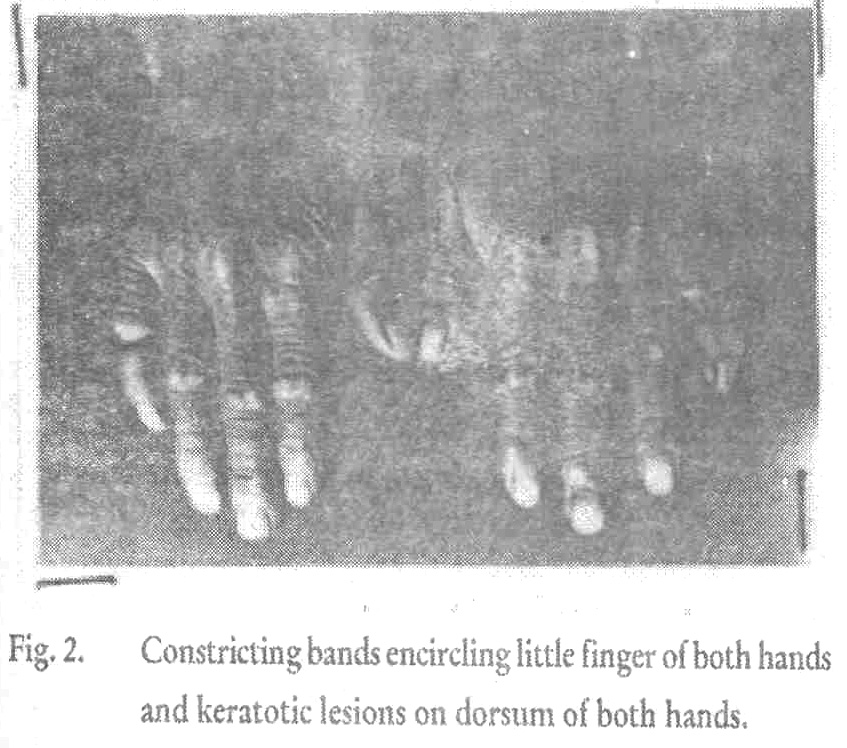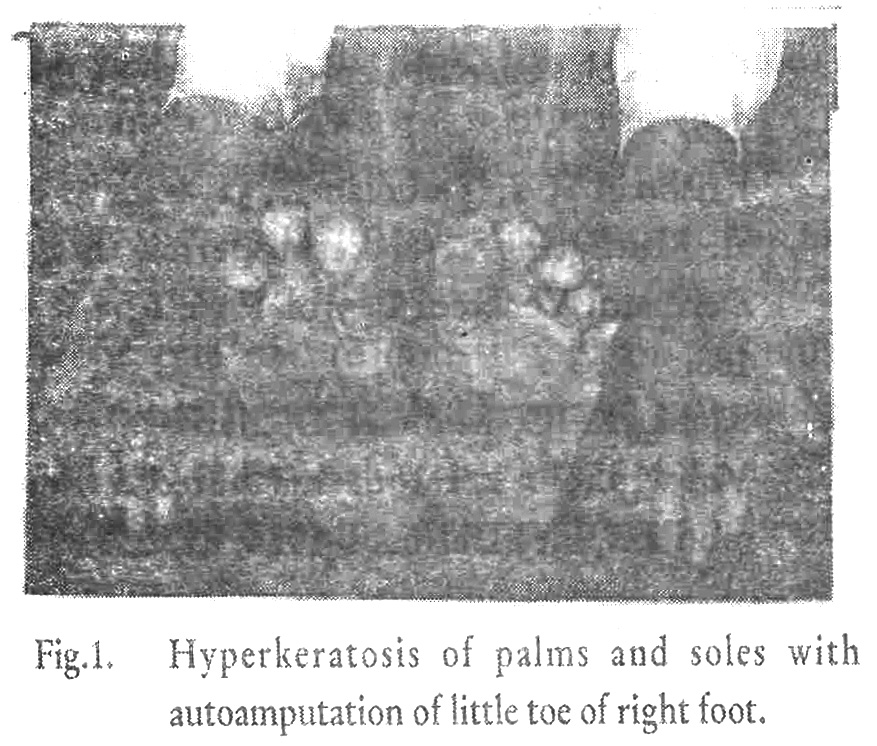Translate this page into:
Keratoderma hereditaria mutilans (vohwinkel's syndrome)
Correspondence Address:
Surabhi Dayal
C/o Dr. S. Dayal,18 Vikas Nagar, Rohtak - 124 001
India
| How to cite this article: Dayal S, Jain V K, Singh H. Keratoderma hereditaria mutilans (vohwinkel's syndrome). Indian J Dermatol Venereol Leprol 1997;63:186-188 |
Abstract
We report two cases of Vohwinkel's syndrome in son and mother presenting with a progressive palmoplantar keratoderma with 'honeycomb' appearance associated with constricting bands encircling digits of hands and feet along with keratotic plaques on dorsum of hands and feet. Both had associated sensorineural deafness. |
 |
 |
 |
Keratoderma hereditaria mutilans or Vohwinkel′s syndrome is a rare disease entity consisting of palmar and plantar hyperkeratosis with a characteristic ′honeycomb′ appearance beginning early in life, keratotic lesions in a typical ′starfish′-like configuration on the dorsa of hands and feet, elbows and knees and constriction bands or rings encircling the digits.[1][2] Familial incidence with an autosomal dominant trait has been reported.[3] Other signs may be associated such as cicatricial alopecia, deafness and plantar bullae, ichthyosiform dermatosis, spastic paraplegia and myopathy.[2][3]
Case Report
A 22-year-old male was noted by his parents to have marked thickening of the skin of his palms and soles when he was about 4 year old. The condition was progressive and disabling and appeared to be worse in winters. Since last 2 years patient started developing constricting bands encircling little finger of both hands and third toe of both feet. The little toe of right foot also developed similar constricting band followed by autoamputation. History of raised keratotic lesions on the dorsum of hands and feet and limitation of movements of digits was present. History of deafness was characteristic. There was no associated alopecia, plantar bullous lesions or ichthyosiform dermatosis in the patient. Examination revealed marked hyperkeratosis of the palms and soles with characteristic ′honeycomb′ appearance [Figure - 1]. Deep fissures were present along the normal skin creases of the palms. Keratotic papules becoming confluent to form keratotic plaques having linear extensions were present on the dorsum of both hands and feet. Constricting bands encircling little fingers of both hands just proximal to proximal interphalangeal joints and third toe of both feet were present [Figure - 2]. The little toe of right foot was autoamputated [Figure - 1] Hair, nails and teeth were normal. X-rays of the hands and feet showed thinning and osteoporotic changes of the bones distal to the constricting bands.
Patient′s mother also had similar disorder starting at the age of 5 years along with autoamputation of the little toe of both feet and little finger of both hands following the development of constricting bands at the age of about 20-22 years. History of deafness in mother was also present. Hair, teeth and nails were normal. No other associated features were present in the mother.
Audiometry showed marked sensorineural deafness in both the cases and no haematological or biochemical abnormality could be demonstrated on routine investigations.
Discussion
Vohwinkel first described a rare disease entity called ′keratoderma hereditarium mutilans′ which consisted of familial hyperkeratosis of palms and soles, keratotic lesions on knees, elbows, dorsum of hands and feet and ainhum-like constriction of the digits.[1] Subsequent reports of this disease included associated findings of high frequency of hearing loss, mutism, alopecia, plantar bullous lesions, ichthyosiform dermatoses, spastic, paraplegia and myopathy.[2][4] Characteristic ′starfish′ keratoses on the dorsum of hands and feet have been described by Gibbs et al.[2] Krishnan et al reported a case of mutilating acral keratoderma, a variant of Vohwinkel′s syndrome in which the involvement of the palms were limited to a localized area and was nonprogressive. No other family member was affected and lacked other features of Vohwinkel′s syndrome.[5]
Our patients had palmoplantar keratoderma, constricting bands around digits and keratotic plaques on dorsum of hands and feet. Sensorineural deafness was observed in both the cases. The disease started in early childhood (4-5 years age) and progressed in severity with formation of constricting bands around digits developing in teens. Thus our cases of son and mother exhibited all the characteristic features of Vohwinkel′s syndrome along with associated deafness.
Current treatment modalities only slightly improve the condition. Retinoids are somewhat effective but full thickness grafting of involed areas of hand and feet provides good results but it is an extensive operative procedure.[6]
| 1. |
Vohwinkel KH. Keratoderma hereditarium mutilans, Arch Dermatol Syphilol 1929;158:354-364.
[Google Scholar]
|
| 2. |
Gibbs RC, Frank SB. Keratoderma hereditaria mutilans, Arch Dermatol 1966;94:69.
[Google Scholar]
|
| 3. |
Camis C, Rossana C. Variant of keratoderma hereditaria mutilans (Vohwinkel's syndrome), Arch Dermatol 1984;120:1323-1328.
[Google Scholar]
|
| 4. |
Rastogi S, Kumar P, Mukhija RD. Mutilating keratoderma with deaf mutism, Ind J Dermatol Venereol Leprol 1996;62:254-255.
[Google Scholar]
|
| 5. |
Krishnan SGS, Yesudian D, Jayaram M et al. Mutilating acral keratoderma, Ind J Dermatol Venereol Leprol 1996;62:187-188.
[Google Scholar]
|
| 6. |
Richard DC, Michael G, Barbara HW. Vohwinkel's keratoderma hereditarium mutilans, Int J Dermatol 1984;23:131-134.
[Google Scholar]
|





